#without unpacking izuku seeing katsuki die
Explore tagged Tumblr posts
Text
all of those think-pieces and chapter predictions about an iz//cha confession, iz//cha floating in the sky together because of ochako's quirk (and that spirited away art), iz//cha kiss, i'll admit I was getting a bit scared despite the fact that none of that would've made any sense....only for nothing of the sort to take place
instead we got izuku + ochako comforting and uplifting each other in a way only they can given what they've gone through,, finally smiling,, being the best friends they are (also surrounded by their other friends!!)...oh I smiled and cheered. going to sleep tonight with a smile, horikoshi your mind, I knew I could trust you
#mind you bkdk still haven't had a formal talk yet...leaving things w the hospital room#which was more of a one-sided breakdown on kats' end#without unpacking izuku seeing katsuki die#they are the core of the series#leaving things at katsuki asking about the embers...oh that can't be it hori i'm onto you#saw some tweets saying bakudeku is finally dead#like....okay if you say so lmao!#no canon ship = bakudeku canon walk with me talk with me#mha 429#bnha 429#bakudeku#mha manga spoilers#bnha manga spoilers#mha spoilers#bnha spoilers#bkdk#dkbk#trust that iz//cha couldve been developed so much more in an explicitly romantic sense if hori wanted to#class 2a storming in...oh that's family#im so glad my daughter ochako got her chance to talk to someone about toga#i love her sm#mmhp
101 notes
·
View notes
Text
The Bakugo Presentation 2.0 Part 2
Sequencing My Hero Academia’s “Manga DNA”: A Breakdown of Katsuki Bakugo Part 2
Welcome to the Bakugo presentation 2.0 part 2!
Link to the Bakugo presentation 2.0 Part 1
Link to the Bakugo presentation 1.0: Part 1 | Part 2
Link to the Kirishima presentation
Link to the Todoroki presentation
Link to the Deku presentation coming eventually
Japan and Bullying
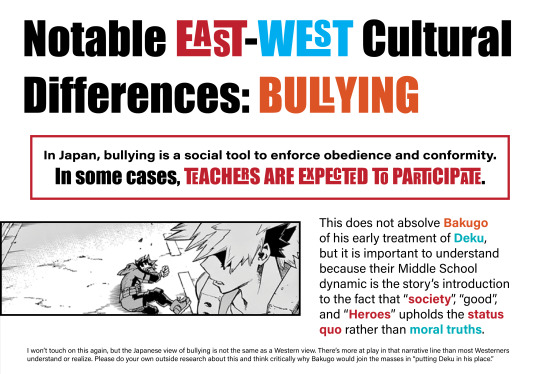
Bakugo implied Deku should jump off a roof. Fact. But “canceling” Bakugo over bullying Deku without acknowledging the series’ point that the motive for “evil” and pressures that inspire it are bigger than just one person is, well, reductive to the thesis of the story. It is also culturally naive.
This article from the Atlantic discusses Japan’s current education climate in a general sense through taking a look at Precarious Japan, but it also includes an interesting comment about bullying: “The notorious bullying in Japanese schools has actually been seen by many parents and teachers as a feature not a bug.”
What does that mean? Well, it can mean a lot of things. But here it means that Bakugo and Deku’s peers and authority figures—and especially Bakugo himself as Deku’s osana najimi (childhood friend)—was expected to bully Deku into fitting into the mold of a quirkless nobody. (That’s not exactly why Bakugo did it, but that is the expectation placed upon him by his social role and the thing that has been signaled to him by society as the correct thing to do regardless of his true motive. He takes it too far in the first chapter, “even for [him]” as his classmates point out, but the act itself is borderline socially sanctioned.) This is also why Bakugo and Deku’s middle school teacher announces Deku’s goal of attending UA to the class. He is actively trying to pressure the dream out of Deku via his peers as professional Heroism isn’t something a quirkless person is suited for. While presented much more condescendingly and aggressively than my next example, the teacher’s underlying logic is the same as Inko Midoriya’s fervent apologies to her son upon his quirkless diagnosis and his realization that it compromises his dream of being a Hero “like All Might”.
In fact, from Inko’s perspective or the perspective of a lot of Japanese parents, Deku being bullied for his quirkless dream in context of his dangerous Hero goals can reasonably be construed as a way of “protecting Izuku from himself.” Repeat it to yourself until it sinks in: “The notorious bullying in Japanese schools has actually been seen by many parents and teachers as a feature not a bug.” I am not saying she would approve of Bakugo telling Deku to “take a swan dive off a building and hope you get a quirk in your next life”, but I am saying that the bullying from Deku’s peers overall is something she likely expected.
While Horikoshi has said in interviews that what Bakugo said at the beginning of the series (“take a swan dive off a building and hope you get a quirk in your next life”) was harsh and cruel (and perhaps even a bit too much even for Bakugo), the spirit of what he was getting at (which would be something like, “You’re mental for thinking you can get into UA, you quirkless shitnerd”) is phenomenally on brand for him.
What do I think as a Bakugo fan? I think Bakugo is more entertaining as a character in part because he is legitimately nasty upon his introduction. Who wants a toothless first-act antagonist that isn’t threatening? That’s boring. That’s so boring. I like Bakugo more for being so aggressively terrible in the beginning because it gives us more to unpack, particularly since Deku’s reaction to it is a clue that their dynamic is utterly complicated. The only thing I might change is the phrasing so Bakugo says more directly, “Go die and see if that gets you a better quirk next time, shitnerd” because the insidious, sideways phrasing of “take a swan dive off the roof” sounds more like something Monoma might say to get under an opponent’s skin.
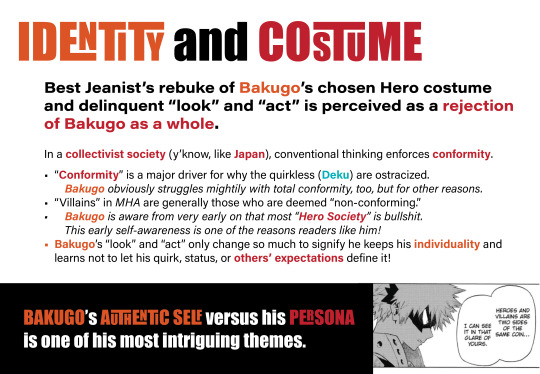
But even more importantly: Bakugo’s role as an early-series representative for the reality of the Hero society in which he and Deku live is established by the complicated relationship the two of them have as osana najimi and bully-victim. Bakugo’s role as a pseudo-conforming bully is also an ideal starting point for his as a character’s journey of awareness of the greater implications of the world around him as well as beginning to look within himself and what he actually values.
Bakugo’s abrasive introduction is an ideal starting point for a character meant to grow into the role of a trickster hero.
My Trickster Hero Academia
An antihero isn’t exactly a trickster hero and a trickster hero isn’t exactly an antihero, but they can overlap. Bakugo’s transition into a “heroic” role isn’t one of exact and consistent conformity. It is instead ambivalent and meant to challenge the social convention by subverting it or using it maliciously to prove a point. Bakugo does this repeatedly (treating Ochako as a legitimate opponent in the Sports Festival; making Kaminari shock himself to lighten the mood; framing the Culture Festival as a challenge and competition rather than a friendly event; Bakugo repeatedly indirectly sniping at Endeavor during their internship; acting up in the Todoroki household in response to Fuyumi and Shoto breaking social convention and discussing their family problems to guests; the harsh dichotomy between what he says, what he means, and how it usually reflects the truth of the world’s reality despite how others try to frame it…)
Usually, the “trickster” part of a trickster hero’s name refers to the character in question stealing or performing the “trick” as an act, but it can refer to general mischief. The Monkey King—the figure on which Goku is based off of and named for—is one of the most famous trickster heroes.
In order for me to explain Bakugo’s most potent tool for the subversion of social convention as well as the most important lens to understand regarding his struggles with identity, I need to explain a distinct feature of modern Japanese social norms.
Honne and Tatemae: Public and Private Faces
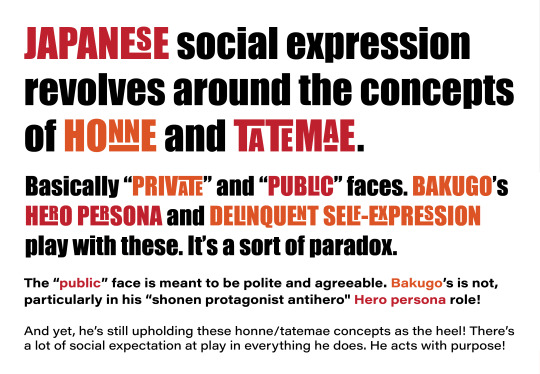
Of all the masks and roles Bakugo puts upon himself, this is the most complicated concept and yet the most important to understand when it comes to his forms of self-expression, “Heroic antiheroism”, and status as a trickster hero: honne and tatemae. Or, in English, the “public face” and the “private face”.
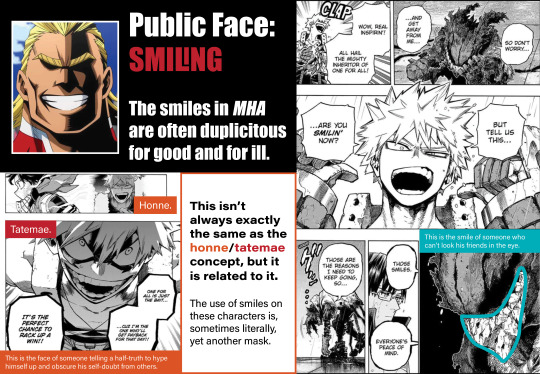
I could not possibly unpack all of honne and tatemae. In fact, I’d hazard a guess that, compared to the grand scheme of all Japanese media, the portrayal of it in MHA ain’t even that deep or complex. But the fact that it exists and has bearing on these characters is worth noting. Bakugo’s struggle with honne and tatemae, while distinctly an Eastern struggle, is also a very common one.

The tatemae is supposed to be friendly or socially acceptable, polite, and professional (or at least match the level of formality/casualness inherent in the setting). In fact, in a professional or social role setting (such as those of “matriarch” or “club president”) the tatemae is almost like a role one is meant to play that supersedes all individual opinion, expression, or presentation. The individual takes on the role society gives them for the benefit of the whole and only “removes” it in private spaces and among those intimately close with the individual (and this does not always mean a husband or wife show their honne to one another. Some may also wear a tatemae of “husband” or “wife” in varying degrees depending on the depth of the relationship.)
Conflicts born from a character’s honne conflicting with their tatemae is a standard theme in Japanese drama. This is the best watered-down analogy I can make: honne/tatemae conflicts are like when characters have to choose between themselves or what they love and some duty they must carry out.
More than anything else, the thing Best Jeanist was trying to groom in Bakugo isn’t exactly his whole personality, but his tatemae and the feelings of cooperation that inspire the use of an agreeable tatemae in the first place. Westerners can think of it like Best Jeanist is trying to groom Bakugo’s “professional face”, but the concept is a little more nuanced than that.
Bakugo’s Tatemae

So, because Bakugo is rude, mean, blunt, and generally obnoxious, this must mean he doesn’t have a tatemae, right? Wrong. Bakugo does have a tatemae: one of a loud, overconfident cartoon delinquent protagonist antihero that makes room for the more negative aspects of his honne. While Bakugo has not completely mastered the art of keeping his honne and tatemae separate, he does have both and he switches between them at will. If you understand this, his antics become a lot more interesting because it is apparent that he, while rarely outright lying, implies one thing with his speech while in pursuit of a seemingly contrasting objective.
If you ever think Bakugo is being completely honest on the surface, you’d best make sure he’s not putting on delinquent airs or smiling his most terrifying battle-ready smile. And even then, you’d best think about why he says what he says before you get a good picture of what he is actually trying to express. The shonen delinquent persona, the shonen protagonist slant to his Hero persona, a literal hero mask… all of these are part of his tatemae. It is understood by most Japanese readers that many of the ways Bakugo portrays himself are his own specific and socially required brand of saving face. Paradoxically, this sometimes includes the moments in which he is breaking conventional tatemae social rules.
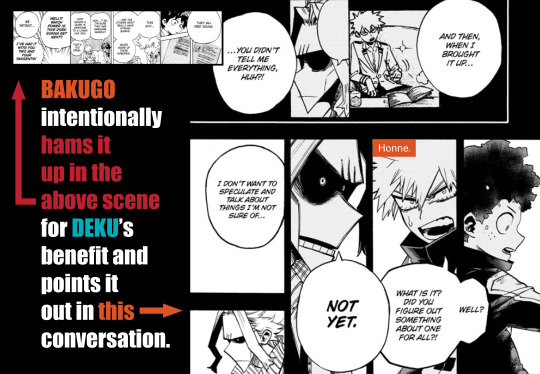
My favorite example is Bakugo’s accompaniment of Deku during the War Arc. Bakugo says he is following Deku in order to get revenge on Shigaraki (which is not totally untrue) and implies with his face (a tatemae “public face” smile) that he is excited by the prospect. Meanwhile, Deku knows that in truth, Bakugo is trying to take responsibility for All Might’s forced retirement, which he feels guilty for having a hand in. The panels even show Deku thinking about his (literal) “private face” honne. To make it more complicated, Deku doesn’t completely understand that Bakugo is trying to protect Deku because he cares about Deku and not just because it is the most tactically sound thing to do for the wielder of One for All.

When Bakugo declares his Hero name, the self-aggrandizing and unheroic-sounding “Great Explosion Murder God Dynamight” to Best Jeanist, he also declares that he is intent on not conforming to the understood tatemae conventions but will do with them as he sees fit. Best Jeanist said a Hero name represents one’s wish, and that is Bakugo’s: to ascend beyond convention and do whatever he wants as he sees fit.
Inarticulate Angry Young Man: Trapped By Tatemae

Bakugo uses his multifaceted tatemae to express his individuality simultaneously to protect and obscure the same thing from others. But the longer one wears a mask, the more it becomes them. While Bakugo always had a burgeoning sense of tatemae (he pretended to be a confident “superior” to Deku despite being absolutely scared shitless of him, after all. Do you think all of that was childish bluster and not just honne/tatemae? Why, yes, it was! But posturing and aggressive fronting to save face overlaps mightily with the tatemae concept in emotionally immature individuals!), he wasn’t very skilled at completely separating it from his honne, nor was he very good at identifying his own honne in the first place.
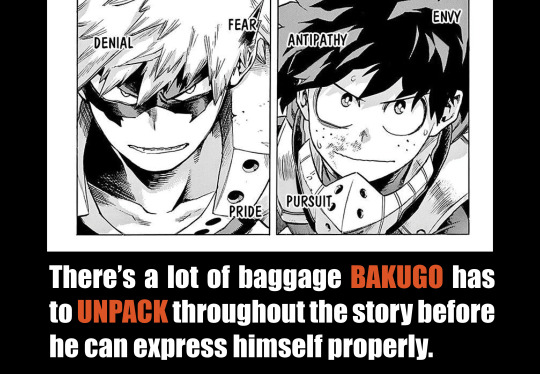
Bakugo is, very pointedly, fighting a war within himself and with the entire concept of social obligation as it pertains to his collectivist society. Even when Bakugo switches between his personas or drops his tatemae to show his honne—or fails to articulate himself well regarding either one—he is consistently aware of the bigger picture. Unfortunately, he isn’t always very skilled at expressing himself directly, especially in the early series and it made a nasty combination with his overlapping, underdeveloped honne/tatemae. The result is a very abrasive teenage boy (who happens to have a superpower.) Like I said in the beginning, Bakugo is, at his core, a very common kind of kid you might find in modern Japan.

The ending of the Sports Festival—and every ham-fisted “I should be your rival!” overture he makes towards Todoroki for the duration of the arc—will forever be my favorite showcase of how Bakugo always has more than one motive that he can’t express AND how bad he is at communicating in a general sense.
Not Just Redemption: Bakugo’s Growth Is in His Honne

Some character arcs are not about changing outward behavior, but rather for changing motives behind that behavior and how much a character understands about their world and the people around them. The original Monkey King’s arc is structured this way. Dragonball’s Goku (the Japanese one more than the one in the dub) likewise follows this model. Bakugo’s arc does as well.
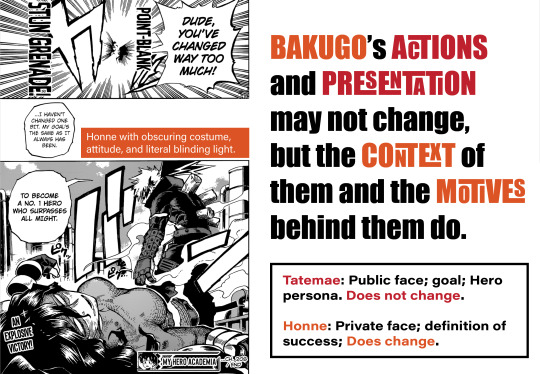
Bakugo points this out himself whenever he refutes other characters insisting he has changed. Bakugo’s arc isn’t one of redemption for redemption’s sake, but rather one of self-awareness. Put simply, he makes a change from an antihero (doing heroic things for unheroic reasons) to a trickster hero (and classic hero, as he occasionally does heroic things for genuinely heroic reasons.) This doesn’t mean Bakugo’s presentation (tatemae) changes. This doesn’t mean he becomes polite.
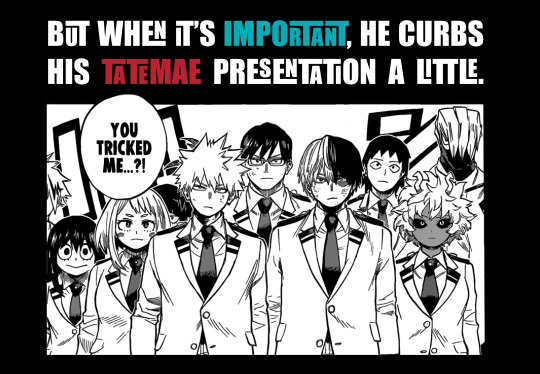
What, the rude exterior is too much for you? Are you still falling into the trap that everything he does is exactly for the reasons it appears at face value and doesn’t have a deeper motive and intentional use behind it?
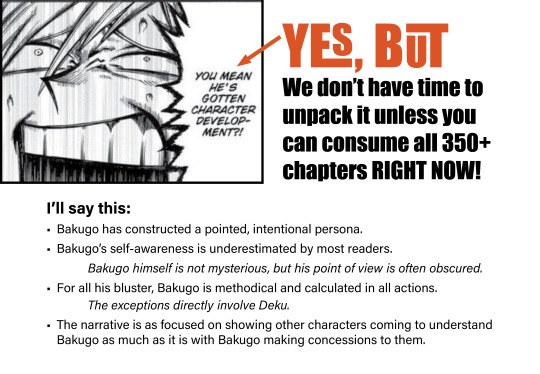
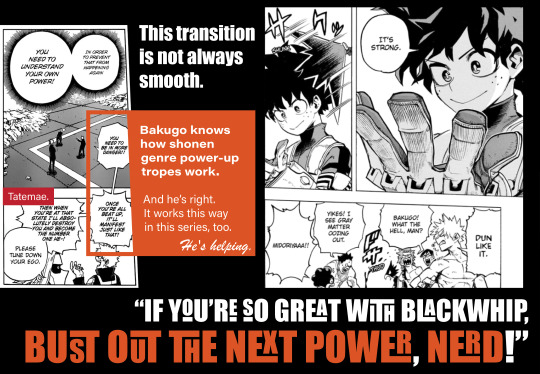
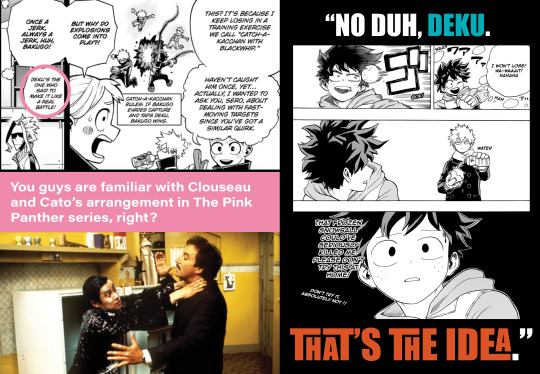





A Hero Name Is A Wish: Tatemae that Reflects an Enlightened Honne
Great Explosion Murder God Dynamight. I adore Bakugo’s Hero name and I will fight anyone who doesn’t. It’s stupid and self-aggrandizing, gives Best Jeanist the middle finger, and is also points out the fact that he realizes he has “reached enlightenment” after figuratively dying and has ascended to godhood. This ascension to enlightenment is the culmination of the Monkey King’s story in Journey to the West—and it follows that it is a major part of Dragonball’s trajectory for Goku.
Also, his Hero name announcement provides comic relief and an in-story morale boost in the middle of a horrific battle - all while he’s bleeding out on the ground. If that doesn’t exemplify Bakugo’s penchant for redirecting the mood, I don’t know what does. He could’ve just said “I’m still alive!” but instead made the choice to pull a stupid stunt.
I’m not done discussing honne and tatemae yet, but before I get any farther I need to touch on another subtopic.
Osana Najimi: Childhood Friends
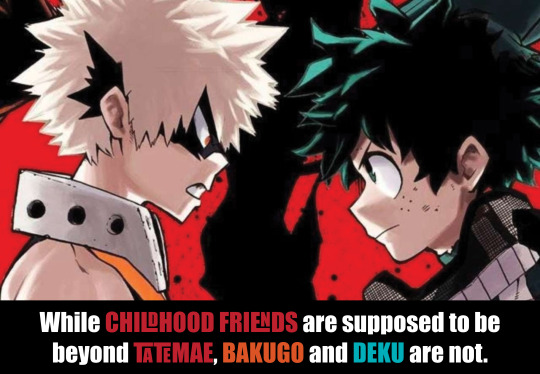
What’s an osana najimi, you ask? It’s a childhood friend much like Bakugo and Deku are. Why is it important that Bakugo and Deku are childhood friends? Because in Japan, these kinds of friendships are forged before kids begin to develop, differentiate, and be expected to uphold the honne and tatemae. They are very valued relationships in many Eastern cultures, Japan included, because they have an intimacy about them that is not accessible in new relationships.
Childhood friends relationships (both the romantic and platonic kind) are romanticized in Japanese media. It’s a whole trope. Bakugo and Deku’s status as osana najimi with an early falling out is an interesting take on the osana najimi trope in anime—particularly in how it alters the understood interpersonal boundaries between Bakugo and Deku as bully-and-victim. That’s also why the other characters point out that the two of them are “childhood friends” as opposed to just “friends a long time ago”.
Here’s a Reddit thread discussing osana najimi in Japanese media to give you more to think about.
Childhood Friends Aren’t Restricted by Tatemae


Or are they? I wonder. While childhood friends are supposed to know one another without tatemae, Bakugo and Deku have, through the rift between them, are in a relationship that forces them both to use a tatemae with one another. As Deku points out, they had never talked things out prior to their fight in Deku vs Kacchan 2. Afterwards, they maintain a relationship centered around training because that is the only indication Deku has given Bakugo that he wants from him. The two of them still do not know what the other is thinking nor are they sure where the boundaries lie.


Manga readers’ mileage may vary when it comes to when they believe Bakugo first wanted to apologize to Deku for bullying him, but he definitely wants to do so earlier than when it actually happens in the manga. It’s interesting to watch Bakugo grapple with it even if he doesn’t deliver entire soliloquies about his internal chemistry. I have an (admittedly) emotionally charged post about it here.
Audience anticipation regarding Bakugo’s apology (and the constant denial of it) is a major source of MHA’s tension. Horikoshi does a great job of making the audience (read: me) care about this moment by making us (read: me) care about Bakugo and the hoops he goes through to tell Deku that he’s sorry.
Making the wronged party feel guilty is not the best way to deliver an apology, and Bakugo knows that. In fact, Bakugo does the most legwork between himself and Deku when it comes to communicating. Despite appearances, Bakugo leads the way on the emotional development and goes out of his way to support Deku whenever he can without overstepping the tentative boundaries between them. To tie this back to the honne and tatemae discussion: sometimes (only sometimes. Not all the time! Sometimes he is just a shit in sincerity) Bakugo’s bad attitude is a security blanket for them both!


The greatest compliment I can give Horikoshi’s writing for Bakugo (and many of the other characters) is that he usually has more than one motive at any given time. He may not express them all well or completely (this is usually one part “he’s bad at communicating” and one part “he is upholding his tatemae” and sometimes “In order to discuss this he would be giving out sensitive information he’s been trusted not to share” and also sometimes “holy crap the other people involved in this situation are truly not ready to talk about it! Good luck navigating that, Bakugo!”)
Bakugo’s Apology and the Mistakes of the Previous Generation
Time to step back into the history within Bakugo and MHA’s shonen DNA.
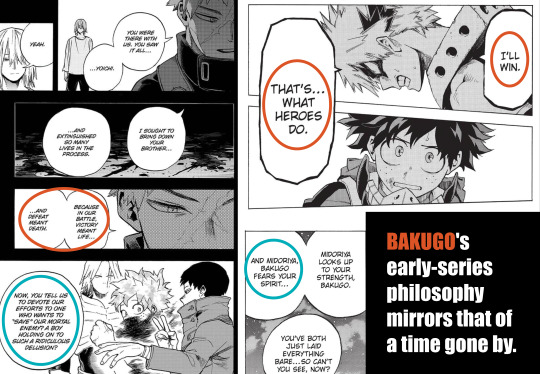
Bakugo’s retrieval of Deku (MHA protagonist with an ambivalently loaded bomb-esque ultimate shonen superpower) from the streets of Kamino alongside the class—as well as his apology—eerily resembles the shade of a classic shonen protagonist from an age gone by talking the new-generation protagonist out of making the same mistakes he did (in emulating the unforgiving, victorious power of the West and becoming a figure just like his predecessors). Considering that All Might, the in-story previous generation superhero mentor (with Western-coded persona), regrets being unable to reach out to Deku and tell him, “don’t make my mistakes” himself, Bakugo’s role as the mouthpiece for the final exchange of 1-A’s retrieval, including language about surpassing All Might, seems to lean even harder in that direction in my mind.
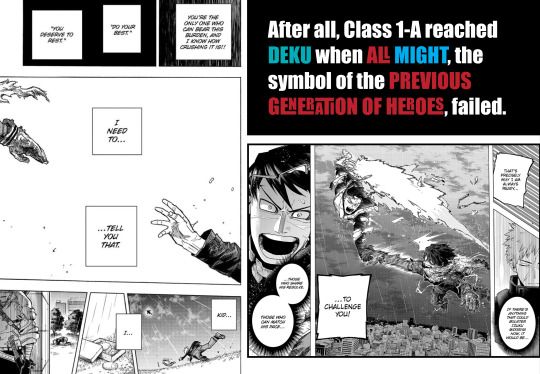
Bakugo was All Might’s proxy and, thanks to all of class 1-A, surpassed All Might in reaching Deku. But he also gave Deku a message that only a classic shonen protagonist who lived through the experience of having the power of a bomb at his fingertips in their shared modern social conditions could.

That Bakugo closely resembles the Second User, a fallen warrior from an age gone by who is focused on the association of victory and life versus failure and death in a literal way rather than a social one like Bakugo, is also something worth noting in this context.
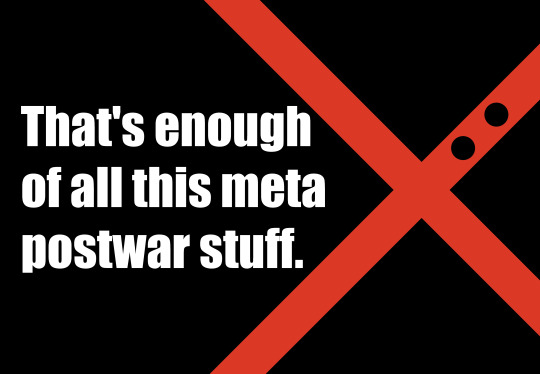
But is it Enough? Lex Talionis and Bakugo
Many MHA fans dislike Bakugo because of his early series treatment of Deku or his continued rudeness. There exists a desire for Deku or someone else to “pay back” Bakugo for his treatment in kind as some sort of retribution, or perhaps for Bakugo to be cowed and his manners curbed into something less loud and aggressive.
While it’s perfectly fine to dislike Bakugo for any reason or find him annoying (I am a fan and I find him annoying), I have to say: this point of view sounds an awful lot like the point of view of the existing hypocritical society in the work. Maybe MHA isn’t the story for those people.
Honne and Tatemae Taken Out of Context: A Note on the Western LGBTQIA+ Community and Bakugo’s Popularity

Westerners don’t share the concept of honne and tatemae, but if you are an individual who has ever tried to “pass” in your current life or former life, you probably understand the paradoxical nature of “fronting” to other people with a social presentation indicating one thing while your personal beliefs and feelings are different. If you don’t, that’s completely fine. Bakugo is a cruddy teen boy with authority problems who is trying to figure himself out. That’s all you need to know. However, speaking specifically to the LGBTQIA+ audience: there sure is a HECK of a lot of correlation between Bakugo’s honne/tatemae experience and a modern queer one.
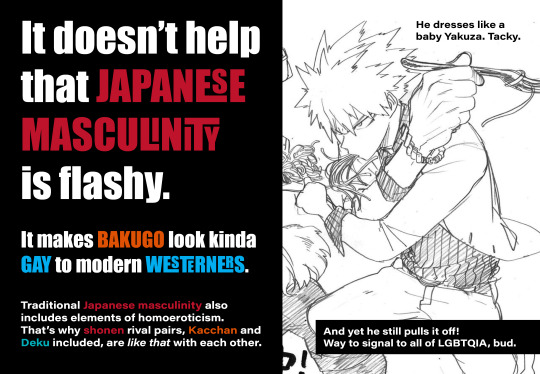
To Western readers in the pertinent queer weeb community, it’s a well-known observation that Goku-esque shonen protagonist types come off as being somewhere on the grey/ace spectrum. This isn’t definitive for any of these characters, but is just something to keep in mind about how certain demographics perceive them. In Bakugo’s case: he is absolutely and completely uninterested in romance or girls, and not even in the “ew cooties” or “that would be embarrassing!” way. His antipathy and boredom with the concept seems sincere. (And if he’s even so much as emotionally interested in anyone, it is restricted to a specific selection of other guys in his class.)

There is not much in media that the asexual and aromantic communities can turn to, so it may as well be found in characters like Bakugo. It’s about all we’ve got.
A Note on Eastern Fujoshi
While this demographic is not interested in connecting with a queer or queer-coded character because they relate to that experience, Bakugo’s, um, canon relationship with characters like Kirishima, Todoroki, or Deku endear him to fujoshi. It is important to note that fujoshi often (but not always! Not always! The fujoshi community is huge and wildly different in different countries) are homophobic in real life but enjoy the fantasy of two dudes in love for their consumption. The fujoshi view and appeal drawn from the idea of Bakugo potentially being in love with another male character is completely different from folks who are actually part of the LGBTQIA+ community!
Anyway, that’s enough about all that gay shit for now. Back to the questions that really matter.
Tsundere: Bakugo’s Last Mask

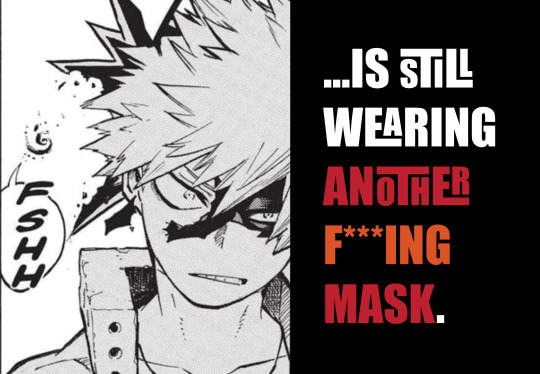
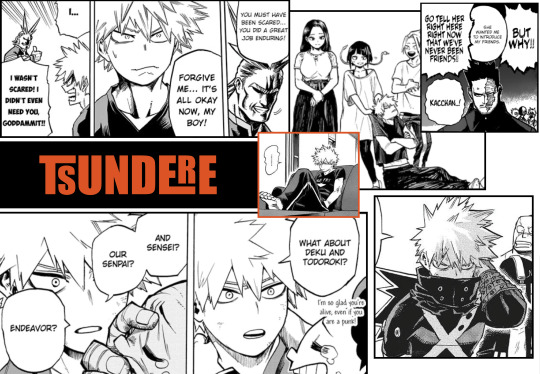
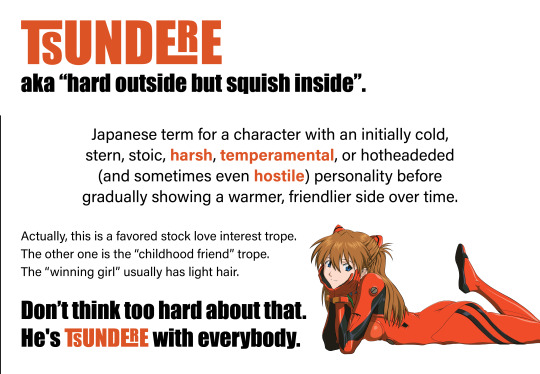
Hi, Asuka Langley Soryu from Neon Genesis Evangelion. I’m so pleased you could join us today for this discussion about aggressive, egotistical tsundere characters who wear red-orange and have complicated feelings about the main character of their series.
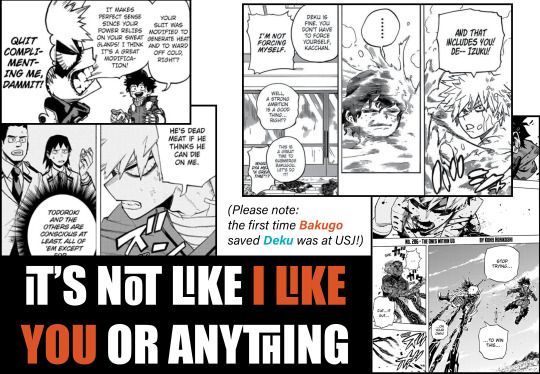
Bakugo is annoying. As a sincere fan, I’m telling you that he is annoying. Somehow, he makes it work. It’s part of the package. While he is not as obnoxious as a moe-style tsundere squealing “it’s not like I like you or anything!”, the trope is the same. And no, I don’t just mean in a potentially romantic context with his osana najimi Deku. I mean that Bakugo is a tsundere to everyone.

As subtle as some of Bakugo’s storytelling can be, just as much of it is comically unsubtle. Ochako Uraraka seeing right through him and eliciting a look of panic on his face is a personal favorite bit of content.
If a reader is paying attention, they may notice a correlation between moments Bakugo either loses or is not wearing his Hero mask and moments his honne, including his flustered tsundere self, appears. One may also notice that, sometimes, the screen-tone shadows on the top of his face in moments of conflict or anger sometimes take the place of his obscuring hero mask.
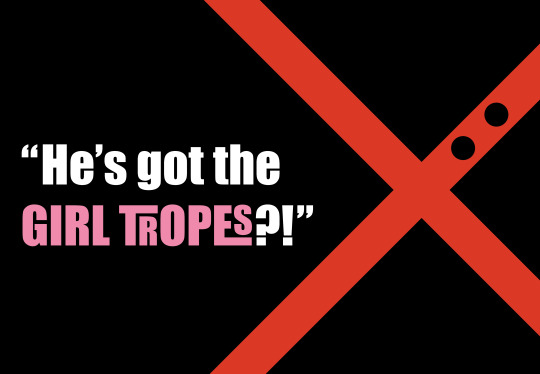
Heroine of the Series?
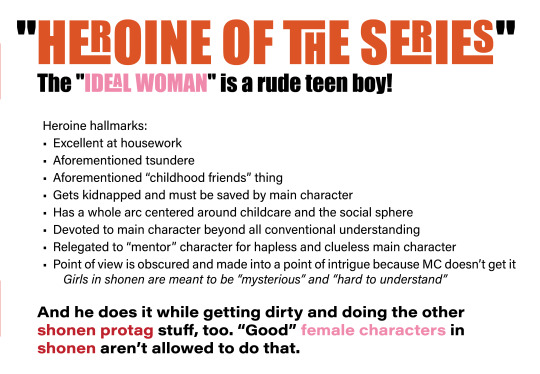
If you didn’t look into that Reddit thread about osana najimi/childhood friends I linked earlier, here it is again for your convenience.
Before I discuss this, I want to once again point out that there are non-romantic osana najimi relationships between same sex characters in lots of media. There’s also plenty of platonic opposite sex osana najimi portrayals. They follow their own set of similar tropes, but what’s interesting about Bakugo is that he incorporates these same-sex tropes as well as the “love interest” osana najimi tropes. No, I am not saying that BakuDeku is canon. I am only pointing out the overlap of tropes present in their relationship.
Osana najimi relationships are often used to evoke security and safety as well as an idyllic past. Depending on the thesis of the work, the main character generally either ends up in a relationship with the (traditionally Japanese in appearance) osana najimi as a representation of maintaining tradition and honoring the past or they end up with the (foreign-looking, exciting, and contentious, and often a tsundere) girl who challenges the main character and represents the future and the outside world.
Bakugo is an osana najimi figure, but he is also a loud, blonde tsundere who is a catalyst for change and mystery for the main character. In conclusion: BAKUGO IS BEST GIRL! AND I DON’T MEAN THAT HE’S GONNA END UP WITH DEKU. I JUST MEAN THAT HE IS BEST GIRL BECAUSE I LOVE HIM AND HE IS THE BEST EVERYTHING!
These osana najimi qualities combined with the fact that Deku saves Bakugo in the series twice inspires some fans to call Bakugo the “Heroine of the series” or even “Princess Kacchan”. It’s just a funny little detail.
Speaking of the ladies.
Shueisha-specific Subversions

I’ve unpacked the history of shonen manga in brief, so I will try to make the culture and history of Shonen Jump publisher Shueisha even more brief: it’s sexist and the standards for portraying women and girls in their shonen series is sexist, too.
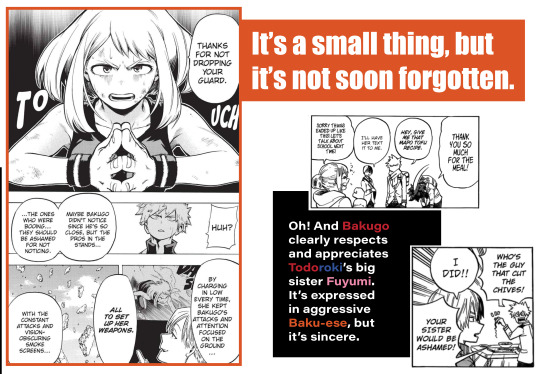
The biggest success of the Uraraka vs Bakugo “girl power moment” is that it has a nice execution, isn’t cloyingly preachy (because let’s be real—Aizawa gives a full sermon to the audience over this), and doesn’t come off as insincere. Of all the conflicts Bakugo has with society and its expectations, the presence of this one within a Jump title is notable. One does not usually read about a female character being taken seriously to the point that the male main characters are allowed to trade blows with them as equals in the ring and not be portrayed as a completely villainous thing. That she loses to Bakugo is second to the point—Uraraka performs well, pulls off something legitimately impressive, and is treated like an equal in the ring for better and for worse.
Is MHA the most feminist of titles? Not by a long shot. But the bar is so low that it is notable whenever anything like this happens.
Bakugo’s choice to fight Uraraka in the Sports Festival despite popular opinion is one of the moments that establishes him as an antihero, by the way.
Cartoon Rage!


Horikoshi is a fantastic illustrator and character actor. Honestly, the amount of charm and expressivity his work imbues his characters with is something I can neither overstate nor begin to even put into words.
I don’t spell this out in the slides, but part of Bakugo’s popularity stems from the fact that he has some of the best background gags. I don’t find him as funny in the anime, but in the manga he consistently makes me smile.


I included some well-known anime shots here, too. If one doesn’t appreciate him when he is screaming “SHINE!” (“DIE!”), one doesn't deserve him at his sparkliest. My personal favorite Bakugo manga face is on the top left corner.
He’s My Hero, But He Doesn’t Have to Be Yours Part II
Bakugo combines genre history, media tropes, and the subversion of cultural norms into one character. While this makes him a strikingly complicated portrayal of a teenaged boy influenced by his world, it also requires the audience to understand the greater context surrounding his creation and influence to foster a full appreciation of his portrayal in MHA. Not everyone appreciates that and that is perfectly ok.
Some people like loud and aggressive characters even without the bigger context of why they might act the way they do. Just as many hate that kind of character regardless of these details. It is what it is. As for me, I love him, but more than that, I appreciate you for reading this. Hopefully, it brought value to your MHA-consumption experience.

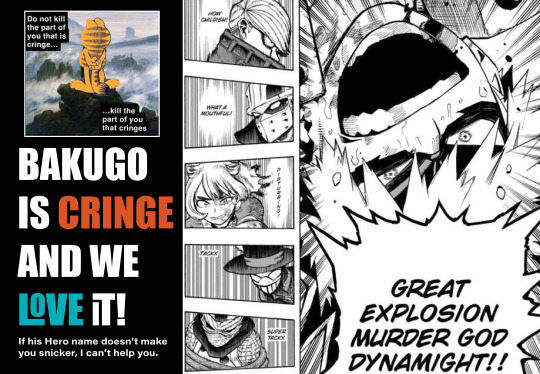




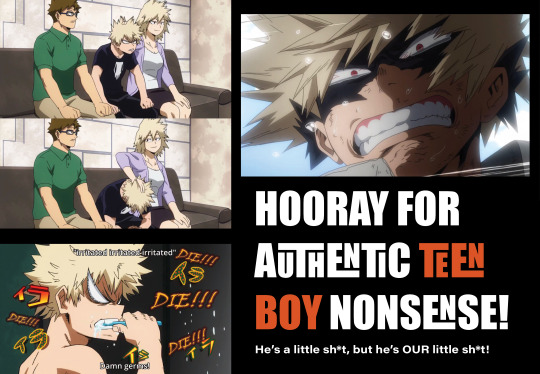
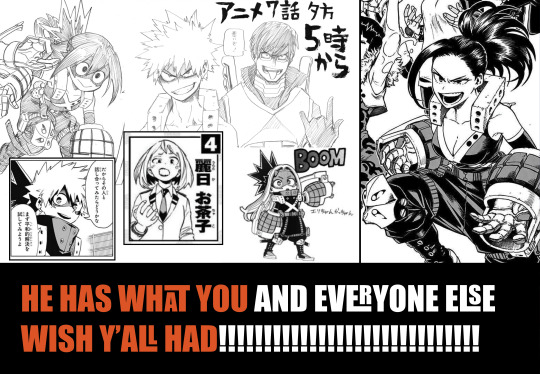
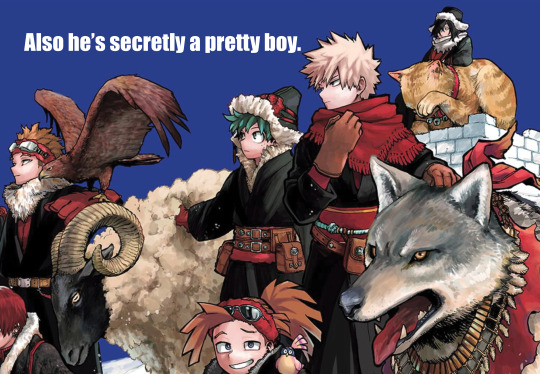
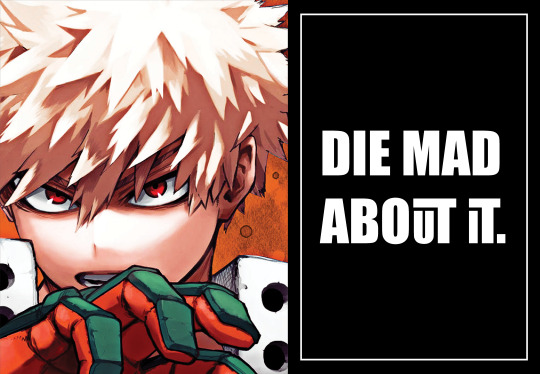
Thank you!
#bakugo katsuki#bakugo presentation#bnha#bnha meta#katsuki bakugo#great explosion murder god dynamight#GEMG Dynamight#heroaca meta#bnha manga#bnha manga spoilers#tsundere#fandom discourse
209 notes
·
View notes